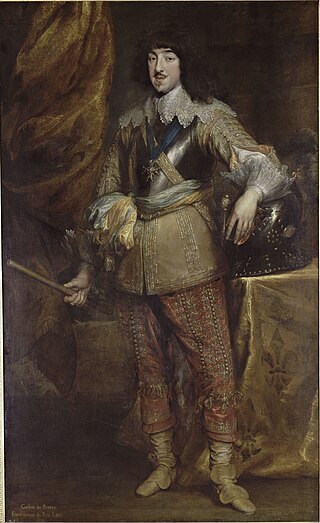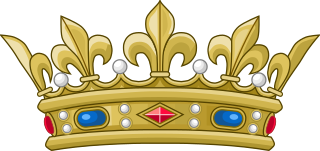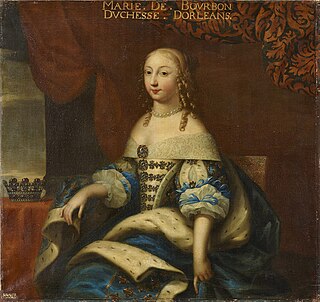Related Research Articles
Styles represent the fashion by which monarchs and noblemen are properly addressed. Throughout history, many different styles were used, with little standardization. This page will detail the various styles used by royalty and nobility in Europe, in the final form arrived at in the nineteenth century.
A prince is a male ruler or a male member of a monarch's or former monarch's family. Prince is also a title of nobility, often hereditary, in some European states. The female equivalent is a princess. The English word derives, via the French word prince, from the Latin noun prīnceps, from primus (first) and caput (head), meaning "the first, foremost, the chief, most distinguished, noble ruler, prince".
A courtesy title is a form of address in systems of nobility used for children, former wives and other close relatives of a peer, as well as certain officials such as some judges and members of the Scottish gentry. These styles are used "by courtesy" in the sense that persons referred to by these titles do not in law hold the substantive title. There are several different kinds of courtesy titles in the British peerage system.
The Most Serene House of Bourbon-Condé, named after Condé-en-Brie, was a French princely house and a cadet branch of the House of Bourbon. The name of the house was derived from the title of Prince of Condé that was originally assumed around 1557 by the French Protestant leader Louis de Bourbon (1530–1569), uncle of King Henry IV of France, and borne by his male-line descendants.

MonsieurGaston, Duke of Orléans, was the third son of King Henry IV of France and his second wife, Marie de' Medici. As a son of the king, he was born a Fils de France. He later acquired the title Duke of Orléans, by which he was generally known during his adulthood. As the eldest surviving brother of King Louis XIII, he was known at court by the traditional honorific Monsieur.

In British heraldry, a coronet is any crown whose bearer is less than sovereign or royal in rank, irrespective of the crown's appearance. In other languages, this distinction is not made, and usually the same word for crown is used irrespective of rank In this use, the English coronet is a purely technical term for all heraldic images of crowns not used by a sovereign, and implies nothing about the actual shape of the crown depicted. A Coronet is another type of crown, but is reserved for the lower ranks of nobility like Marquesses and Marchionesses, Earls and Countesses, Barons and Baronesses, and some Lords and Ladys. The specific design and attributes of the crown or coronet signifies the hierarchy and ranking of its owner.
Count of Guise and Duke of Guise were titles in the French nobility.

Duke of Châtellerault is a French noble title that has been created several times, originally in the Peerage of France in 1515. It takes its name from Châtellerault, in the Vienne region.
Infante, also anglicised as "infant" or translated as "prince", is the title and rank given in the Iberian kingdoms of Spain and Portugal to the sons and daughters (infantas) of the king, regardless of age, sometimes with the exception of the heir apparent or heir presumptive to the throne who usually bears a unique princely or ducal title. A woman married to a male infante was accorded the title of infanta if the marriage was dynastically approved, although since 1987 this is no longer automatically the case in Spain. Husbands of born infantas did not obtain the title of infante through marriage, although they were occasionally elevated to the title de gracia at the sovereign's command.

Fils de France was the style and rank held by the sons of the kings and dauphins of France. A daughter was known as a fille de France.

The 4th House of Orléans, sometimes called the House of Bourbon-Orléans to distinguish it, is the fourth holder of a surname previously used by several branches of the Royal House of France, all descended in the legitimate male line from the dynasty's founder, Hugh Capet. The house was founded by Philippe I, Duke of Orléans, younger son of Louis XIII and younger brother of Louis XIV, the "Sun King".
Hereditary titles, in a general sense, are nobility titles, positions or styles that are hereditary and thus tend or are bound to remain in particular families.
Prince étranger was a high, though somewhat ambiguous, rank at the French royal court of the Ancien Régime.

Louise Marie Adélaïde de Bourbon, Duchess of Orléans, was the daughter of Louis Jean Marie de Bourbon, Duke of Penthièvre and Princess Maria Teresa d'Este. At the death of her brother, Louis Alexandre, Prince of Lamballe, she became the wealthiest heiress in France prior to the French Revolution. She married Louis Philippe II, Duke of Orléans, the "regicide" Philippe Égalité, and was the mother of France's last king, Louis Philippe I. She was sister-in-law to Marie Thérèse Louise, Princess of Lamballe, and was the last member of the Bourbon-Penthièvre family.

Marie de Bourbon, Duchess of Montpensier, and Duchess of Orléans by marriage, was a French noblewoman and one of the last members of the House of Bourbon-Montpensier. Her parents were Henri de Bourbon, Duke of Montpensier and Henriette Catherine de Joyeuse, Duchess of Joyeuse in her own right.

The House of Bourbon-Penthièvre was an illegitimate branch of the House of Bourbon, thus descending from the Capetian dynasty. It was founded by the duc de Penthièvre (1725–1793), the only child and heir of the comte de Toulouse, the youngest illegitimate son of Louis XIV of France and the marquise de Montespan, and his wife, Marie Victoire de Noailles, the daughter of Anne Jules de Noailles, duc de Noailles.

A prince du sang or prince of the blood is a person legitimately descended in male line from a sovereign. The female equivalent is princess of the blood, being applied to the daughter of a prince of the blood. The most prominent examples include members of the French royal line, but the term prince of the blood has been used in other families more generally, for example among the British royal family and when referring to the Shinnōke in Japan.

The House of Bourbon-Montpensier or Maison de Bourbon-Montpensier was a semi royal family. The name of Bourbon comes from a marriage between Marie de Valois, comtesse de Montpensier (1375–1434) who married Jean de Bourbon - the duc de Bourbon. The second name of Montpensier, comes from the title of the family.
Under the Ancien Régime, the goods of the House of Orléans comprised two distinct parts : the apanage and the "biens patrimoniaux".
References
- ↑ "Courtesy Title". Collins English Dictionary . Collins. Archived from the original on 30 November 2016. Retrieved 29 November 2016.
- ↑ "Courtesy Title". OxfordDictionaries.com. Oxford University Press. Archived from the original on 25 September 2016. Retrieved 29 November 2016.
- ↑ "ComDor Editorial Style Guide: Titles and Courtesy Titles". Massachusetts Institute of Technology. Archived from the original on 2 November 2012. Retrieved 15 February 2013.
- 1 2 Velde, François. "Titles of Nobility". Heraldica.org. Archived from the original on 20 May 2011. Retrieved 27 May 2011.